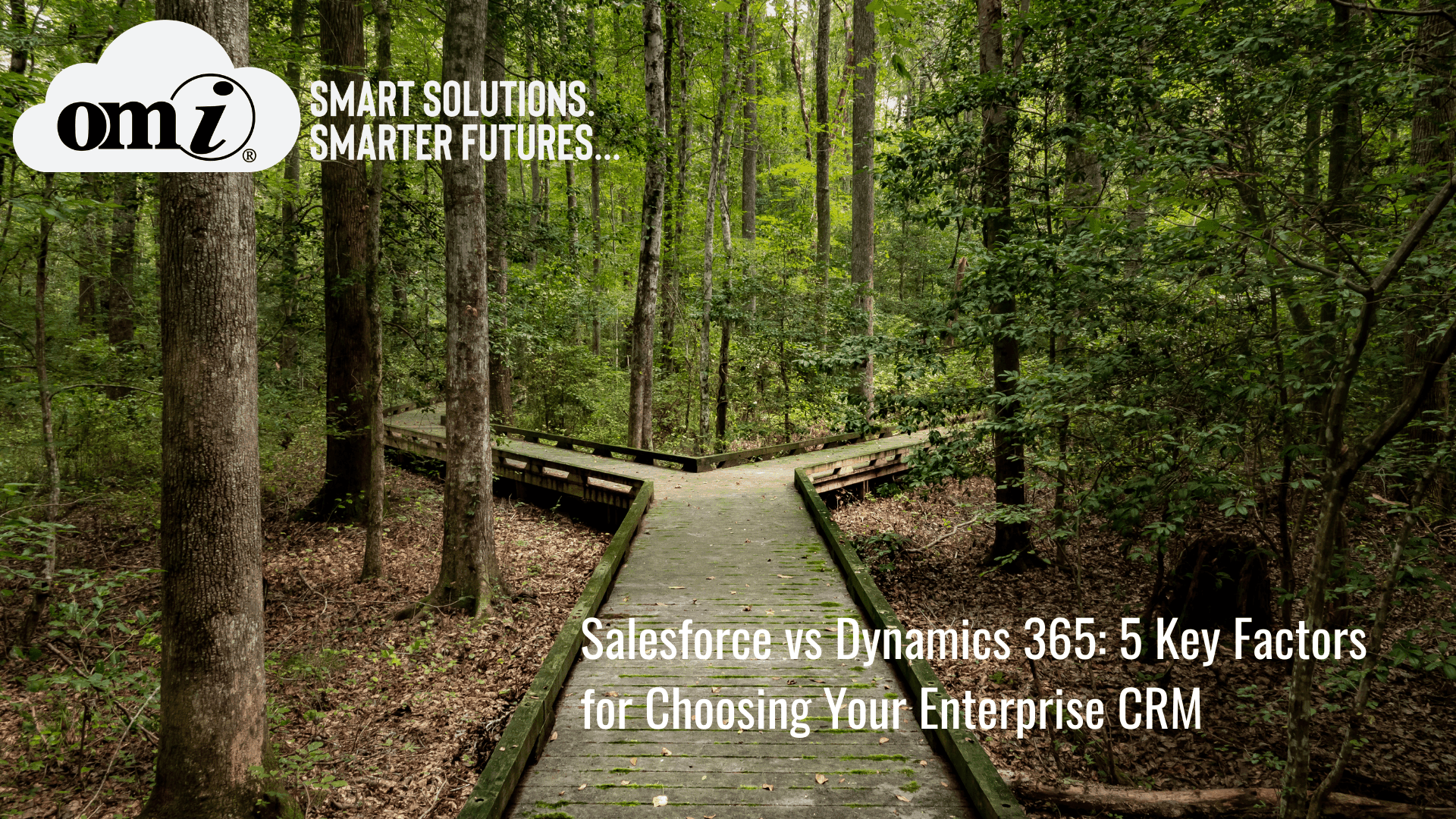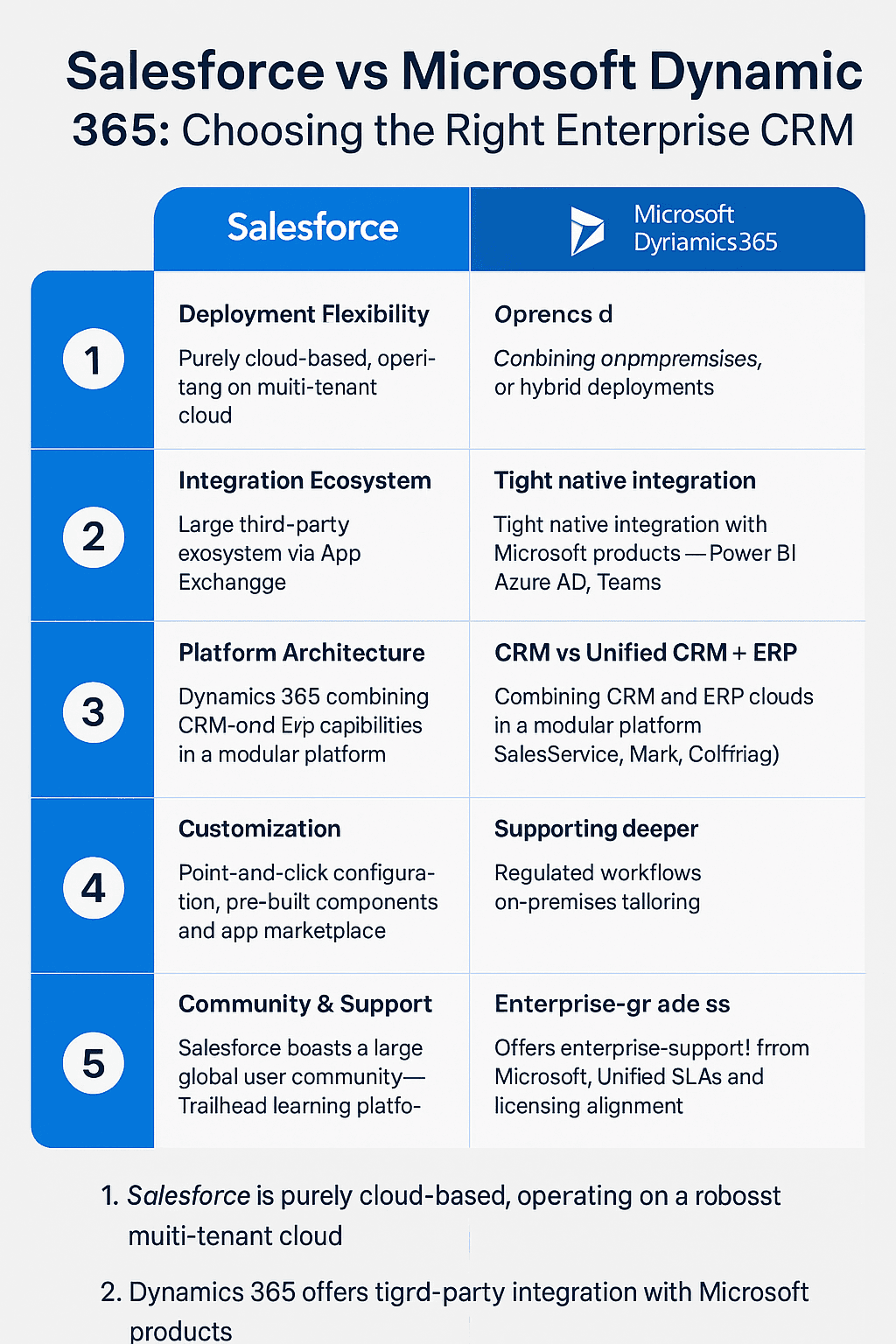Salesforce vs Dynamics 365: 5 Key Factors for Choosing Your Enterprise CRM
September 29
Salesforce
Microsoft Dynamics
Blog

Choosing between Salesforce and Microsoft Dynamics 365 for your enterprise CRM is more than a checklist exercise it’s about aligning technology with your business strategy, culture, and future vision. At OMI, we've spent over two decades guiding organizations through these decisions, and we've witnessed first-hand the profound operational impact these platforms can have across industries. Forrester’s 2024 CRM Wave highlights Salesforce as a market leader for customer engagement and ecosystem breadth, while noting Microsoft Dynamics 365’s strength in scalability and native integration with enterprise workflows. In this guide, we’ll walk you through five core differences, highlight where we see true value emerge, and empower you with insights to make a confident, informed decision for your enterprise CRM journey.
1. Deployment Flexibility: Are You Ready for the Cloud or Need Options?
One of the most overlooked factors in CRM selection is deployment flexibility.
- Salesforce is purely cloud-based, operating on a robust multi-tenant cloud. This means lower infrastructure overhead, accelerated rollouts, and seamless updates, but it requires a commitment to full cloud adoption for your CRM environment.
- Microsoft Dynamics 365 distinguishes itself by offering cloud, on-premises, or hybrid deployment (especially for certain modules such as Finance and Operations). This flexibility is key for industries with regulatory compliance demands or legacy infrastructure to integrate.
Our observation: If your enterprise is already cloud-native or wants to eliminate infrastructure management, Salesforce’s simplicity is compelling. For organizations with complex compliance needs or hybrid strategies, Dynamics 365’s options can reduce friction and future-proof technology investments.
2. Integration Ecosystem: Which Platform Feels Like Home?
Modern CRMs don’t operate in a vacuum. Real business value is unlocked when your CRM integrates seamlessly with other enterprise apps. Here’s how Salesforce and Dynamics 365 stack up:

Our clients leveraging Microsoft technologies often realize dramatic productivity gains thanks to the tight native integrations think real-time reporting straight in Power BI, unified identity management, and leveraging Teams as a sales and service hub. If your digital workspace already runs on Microsoft, Dynamics 365 can feel like an intuitive extension, saving integration time and cost compared to third-party middleware approaches.
3. Platform Architecture: CRM, ERP, and Modular Scaling
This is a crucial consideration if you’re mapping out not just today’s sales pipeline, but tomorrow’s expansion into finance, operations, or field service. Here’s what stands out:
- Dynamics 365 offers a true modular platform that combines both CRM and ERP capabilities. You can start with Sales, scale into Customer Service, Field Service, or expand into Finance and Operations without re-architecting your entire tech stack. This pay-per-capability model means you only invest where you need it, when you need it.
- Salesforce is focused on breadth and depth in CRM and customer-facing functions. Its many clouds (Sales, Service, Marketing, Commerce) function as part of a unified CRM experience, with ERP & back-office needs handled through partner integrations.
What does this mean in practical terms? If you have a clear need for tailored, cross-departmental workflows today or you expect rapid business expansion into areas like supply chain or enterprise resource planning Dynamics 365 can provide a smoother, unified path. If your world is squarely customer-facing and you want best-in-class sales and marketing, Salesforce stands tall as a pure CRM leader.
4. Customization: Speed Versus Depth
No two businesses use CRM the same way. Whether you require a highly regulated workflow for healthcare, want the agility to launch new products, or need to provide unique self-service experiences for customers, customization matters.
- Salesforce is a champion for configurability and rapid prototyping. Its point-and-click interface, pre-built components, and app ecosystem empower business users to spin up new workflows with minimal IT intervention.
- Dynamics 365 is engineered for deeper, often more complex customizations, including tight process controls, advanced data role segmentation, and on-premises configurations. For many regulated enterprises (finance, manufacturing, public sector), that depth means the flexibility to meet compliance or industry requirements with confidence.
We find the right approach often blends both using configurability to accelerate business change, and deep customizations where security or vertical needs demand it. That’s where expert guidance becomes invaluable: mapping your unique business context onto each platform’s strengths, without over-engineering the solution.
5. Community & Support: Navigating Your CRM Journey
Change management and internal adoption are just as critical as features. Here’s how support and community resources compare:
- Salesforce boasts a massive, globally distributed user community, a wealth of training resources, and “Trailhead” learning journeys. This means problems are frequently solved, skills are easy to hire, and peer support is always available.
- Dynamics 365 offers direct alignment with Microsoft’s enterprise support teams perfect for organizations that value unified support SLAs, dedicated resources, and integration with enterprise Microsoft licensing and deployment programs.
From our perspective, the support dimension is not “better or worse,” but “different ways of supporting change.” For some, the vibrant Salesforce ecosystem is irreplaceable; for others, the assurance of Microsoft’s enterprise commitments tips the scales.
The OMI Perspective: How We Help Enterprises Navigate This Choice
At OMI, we don’t sell technology we architect transformation. Our hands-on experience implementing and optimizing both Salesforce and Dynamics 365 for enterprise clients means we’re often brought in to clarify gray areas, quantify real costs, and ensure your investment accelerates business outcomes.
Some key questions we guide decision-makers through:
- Is your business ready to go fully cloud, or do you need to stage your migration?
- Does your workforce rely on Microsoft 365, Teams, or proprietary back-office systems?
- Will you need to integrate advanced analytics, AI, or automate cross-departmental processes?
- Are there compliance, security, or industry-specific workflows that demand deep tailoring?
- What’s your long-term vision: CRM only, or seamless digital operations end-to-end?
The answers to these shape not just the right CRM technology, but the approach to roll-out, integration, and ongoing evolution as your organization grows.

The Right CRM Isn’t a Feature List It’s a Strategic Fit
Whether you lean towards Salesforce’s speed, innovation, and cloud-first philosophy or Dynamics 365’s enterprise depth and Microsoft DNA, the choice should always be rooted in your context not just lists of features. The right fit is where your technology not only answers today’s business challenges but fuels tomorrow’s opportunities, with minimal friction and maximum agility.
If you’d like to explore how Salesforce, Microsoft Dynamics 365, or hybrid models could fit your enterprise, connect with us at OMI. We’re passionate about transforming CRM into a true driver of growth, customer satisfaction, and operational excellence backed by the experience of 1,000+ successful projects worldwide.